==================
Florida Splendors is supported by our audience. When you purchase through one of our links, we may earn a small affiliate commission. As an Amazon Associate I earn from qualifying purchases. Your cost is not affected.
The Everglades is a unique and breathtaking ecosystem with some of the best bird-watching opportunities I’ve ever experienced. Whether you’re an experienced birding enthusiast or just starting, the bird-watching trails in the Everglades offer countless chances to observe an incredible array of bird species. From majestic wading birds to colorful songbirds, it’s truly a bird-watcher’s paradise, and the trails here are the perfect way to immerse yourself in it all.
As I’ve explored the Everglades, I’ve discovered that each trail offers a different experience, allowing you to see something new every time. Whether it’s the tranquil sawgrass marshes, the peaceful mangrove forests, or the wide open waters, there’s always something special waiting to be found. These trails not only allow you to spot native birds but also to connect with the natural beauty that makes the Everglades such a remarkable place. Let me take you through some of this incredible destination’s best bird-watching spots!
Top Bird-Watching Trails to Explore in the Everglades
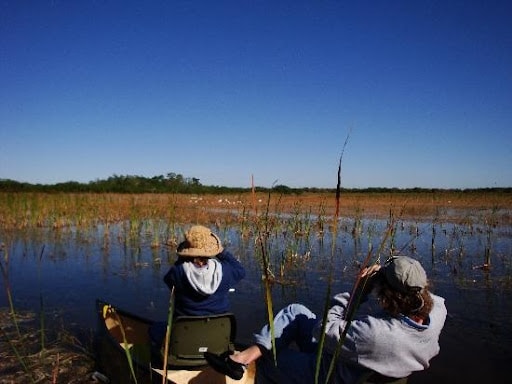
Exploring the Everglades feels like stepping into a different world, with its unique ecosystem that you won’t find anywhere else. Stretching over 1.5 million acres of wetlands in southern Florida, it’s a place with life, making it a dream destination for those who love bird-watching trails in the Everglades. The vast and diverse habitats throughout this region provide endless opportunities to spot various bird species, making it a must-visit for birding enthusiasts.
The Everglades isn’t your ordinary wetland; it’s a vibrant mix of marshes, mangroves, and swamps, all teeming with wildlife. This diversity provides the perfect backdrop for bird-watching, as it’s home to over 350 species of birds. Whether you’re chasing after the flash of a roseate spoonbill or the sleek silhouette of a snail kite, the variety here is mind-blowing.
What sets the Everglades apart is its role as a crucial habitat for a wide range of bird species. From wading birds to raptors and migratory songbirds, the Everglades acts as a pitstop or permanent home for these avian wonders, so it’s no surprise it’s such a hot spot for bird watchers.

Key Highlights: Best Bird-Watching Trails in the Everglades
-
Anhinga Trail: A Bird-watcher’s Paradise The Anhinga Trail is one of the most accessible and rewarding bird-watching spots, offering a variety of water-loving birds like herons, egrets, and anhingas. The boardwalk offers close-up views, making it ideal for photography and easy exploration.
-
Gumbo Limbo Trail: A Hidden Gem for Forest Birds A short, lush trail surrounded by a vibrant canopy, perfect for spotting woodpeckers, warblers, and owls. It’s an ideal spot for a peaceful, contemplative bird-watching experience.
-
Shark Valley: A Scenic 15-Mile Loop Known for its diverse habitats and bird species, Shark Valley offers a 15-mile loop accessible by walking, biking, or tram tour. The area is prime for observing raptors, herons, and egrets.
-
Nine Mile Pond Canoe Trail: Bird Watching from the Water For a unique perspective, the Nine Mile Pond Canoe Trail offers a quieter, more intimate bird-watching experience, allowing for close encounters with water birds like the tricolored heron and little blue heron.
-
Flamingo Visitor Center Trails: Family-Friendly Bird-watching With accessible trails like the Guy Bradley Trail and Eco Pond, the Flamingo Visitor Center area offers a variety of bird species, from flamingos to pelicans, making it a perfect family-friendly spot to enjoy nature together.
Best Time to Visit the Everglades for Bird Watching
When planning a visit to the Everglades for bird watching, timing can be everything. Different seasons bring different experiences; understanding these patterns can be a game-changer.

December to March
Migratory birds bring the Everglades to life from December through March, offering spectacular sights. These cooler months are prime for bird watching, with many species stopping by during their long travels. Think of it like catching a glimpse of avian celebrities taking a break from the hustle and bustle of their migratory routes.
November to April
Weather absolutely plays its part, too. From November to April, the dry season is generally the best time to visit. Fewer mosquitoes are buzzing about, and lower water levels mean birds gather in larger numbers at accessible spots. If you’ve set your heart on certain species, aligning your visit with these natural rhythms could maximize your chances of spotting them.
Things to Remember
A little planning goes a long way. Check out local weather forecasts and maybe even bird activity reports from ranger stations to prepare for your adventure. Packing essentials like sunblock, Water, and a hat can keep you comfy while you’re busy scoping out those feathered friends.
No matter when you choose to go, the Everglades is always ready to deliver an unforgettable bird-watching experience. Having a flexible plan and being ready to soak in all the sights and sounds will make your visit special.

Top Trail: Anhinga Trail
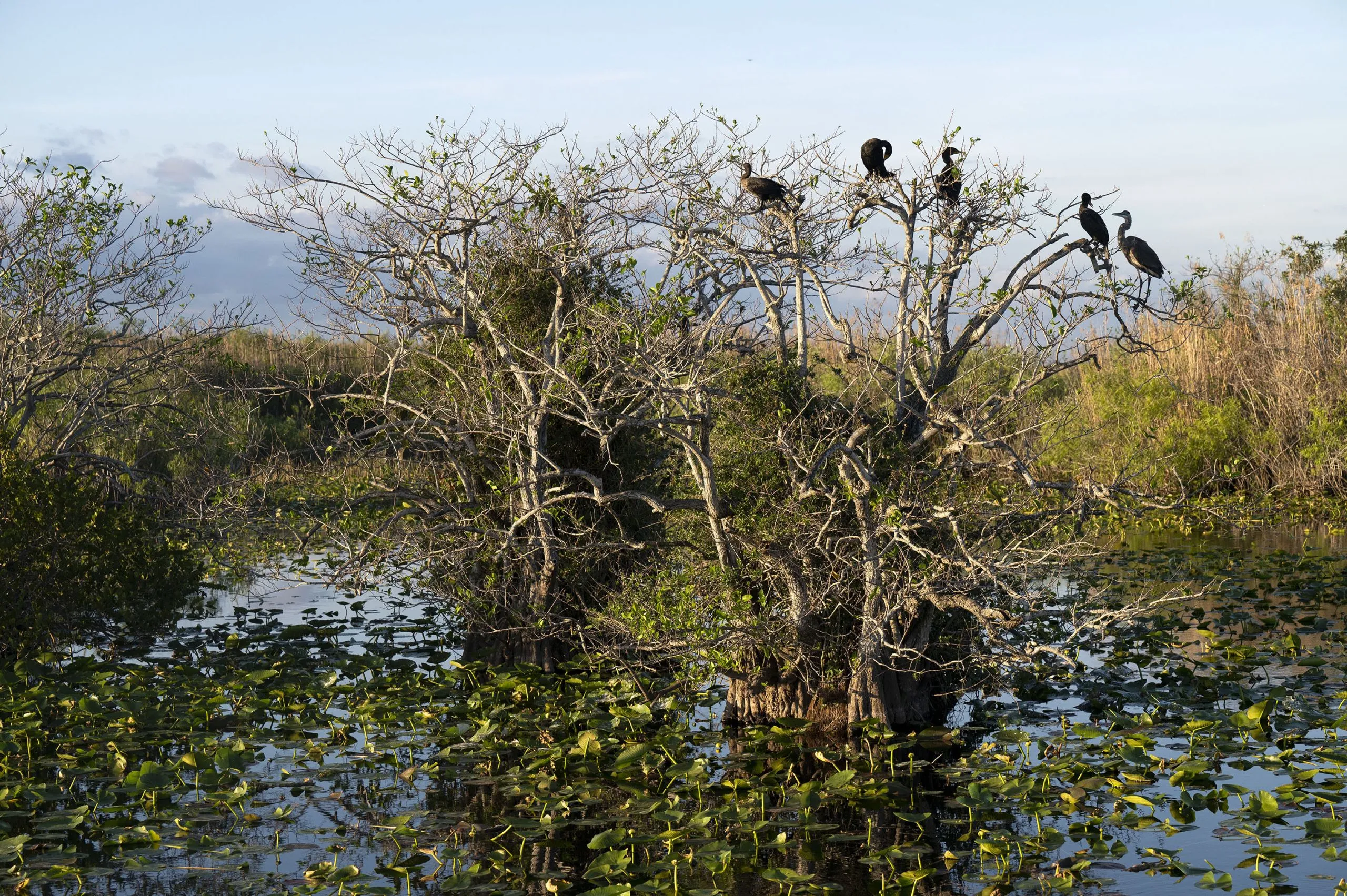
The Anhinga Trail is one of the most accessible and rewarding bird-watching spots along the bird-watching trails in the Everglades. Located near the Royal Palm Visitor Center, it’s a short trail, only about a mile round trip, making it perfect for seasoned bird watchers and families with kids.
Variety of Birds
What makes Anhinga Trail stand out is the sheer variety of birds in a relatively compact area. It’s famous for its abundance of water-loving birds like herons, egrets, and the trail’s namesake—the Anhinga. These birds often dry their wings in the sun, creating excellent photo opportunities.
Close Viewing
The trail features a boardwalk that winds through a sawgrass marsh, offering an up-close view of the birds. It’s common to spot other wildlife, from alligators to turtles, all from the safety of the path. This accessibility allows you to enjoy the flora and fauna without disturbing them in their natural habitats.
Tips
I highly recommend first-timers hitting up Anhinga Trail early in the morning or late in the afternoon. The birds are more active during these cooler parts of the day, and the lighting conditions are perfect for photography. Plus, it’s much less crowded at these times, giving you a more intimate experience with nature.
While the trail is pretty straightforward, bringing a pair of binoculars and a bird guidebook can enhance your visit. With these tools in hand, identifying even the less common species becomes a fun challenge, making your bird-watching adventure all the more rewarding.
Gumbo Limbo Trail: An Underrated Gem
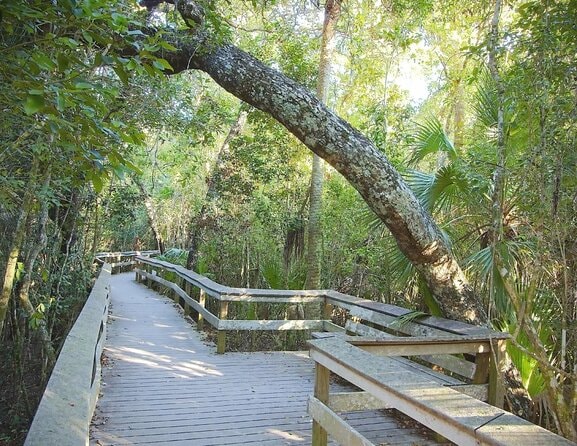
Gumbo Limbo Trail offers a quieter, more shaded bird-watching experience in the heart of the Everglades. This trail is nestled within the Royal Palm area, not far from the more popular Anhinga Trail, but it provides a different vibe and an escape from the crowds.
Lush Canopy
What sets Gumbo Limbo apart is the lush canopy that surrounds the trail. This makes it a hotspot for spotting smaller bird species that prefer forested environments. Woodpeckers, warblers, and owls are commonly found here, along with the trail’s namesake, the gumbo limbo tree, which also attracts several bird species.
Amazing Path
The path is a leisurely half-mile loop, ideal for bird watchers who enjoy a more contemplative experience. It’s fairly accessible, with a mix of boardwalk and dirt trails, so it’s easy on the feet and perfect for a slow-paced stroll.
Nearby Trails
Pairing a visit to Gumbo Limbo with nearby trails can make for a full day’s adventure. It allows enthusiasts to experience diverse habitats close to them, each attracting different bird populations. This blend can be exciting for those looking to expand their bird-watching lists and embrace the full spectrum of what the Everglades offers.
Visiting Gumbo Limbo is best during the early morning when the light filters beautifully through the canopy, creating perfect conditions for viewing and photographing birds. So, pack your essentials, take your time, and enjoy this little gem’s unique tranquility.

Shark Valley: A Scenic Bird Watching Haven
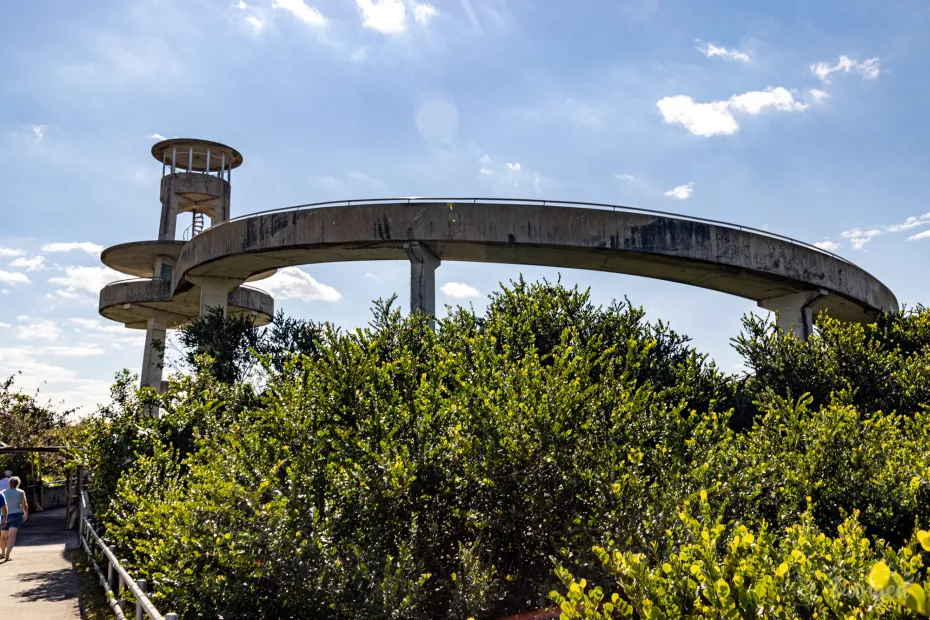
Shark Valley is one of those must-visit spots for bird-watching enthusiasts exploring the bird-watching trails in the Everglades. Located on the northern border of the national park, this area offers a stunning mix of landscapes that attract a variety of bird species.
Known for 15 Mile Loop
This place is known for its 15-mile loop, where you can walk, bike, or take a tram tour. Each mode offers its own unique bird-watching perks, but biking might be the sweet spot if you’re up for a bit of exercise with your birding. It’s flat and smooth, so no worries if you’re not a mountain biking pro.
Different Habitats
The vistas here are unbelievable. During your journey, you’ll cross different habitats, from grassy marshes to tree islands, each bustling with bird activity. This diversity makes it an ideal spot for seeing raptors. Keep your eyes peeled for the impressive sight of a bald eagle in flight or the occasional peregrine falcon.
If you’re here for classic Everglades sights, gigantic blue herons and great egrets wading through the Water should be on your checklist. They’re a part of the scenery, practically waiting for visitors to admire them.
Timing is Crucial
Timing your visit is crucial here as well. Early mornings or late afternoons, when birds are most active, will deliver the best experience. Also, sunset is a special time at Shark Valley; there’s nothing quite like seeing the sky change colors over the expansive wetland, with birds silhouetted against the horizon.
Having a knowledgeable guide is a bonus for those venturing out on a tram tour. They can point out bird species you might miss and share insights about the ecosystem, making the experience richer and more rewarding.
Nine Mile Pond Canoe Trail: A Unique Perspective
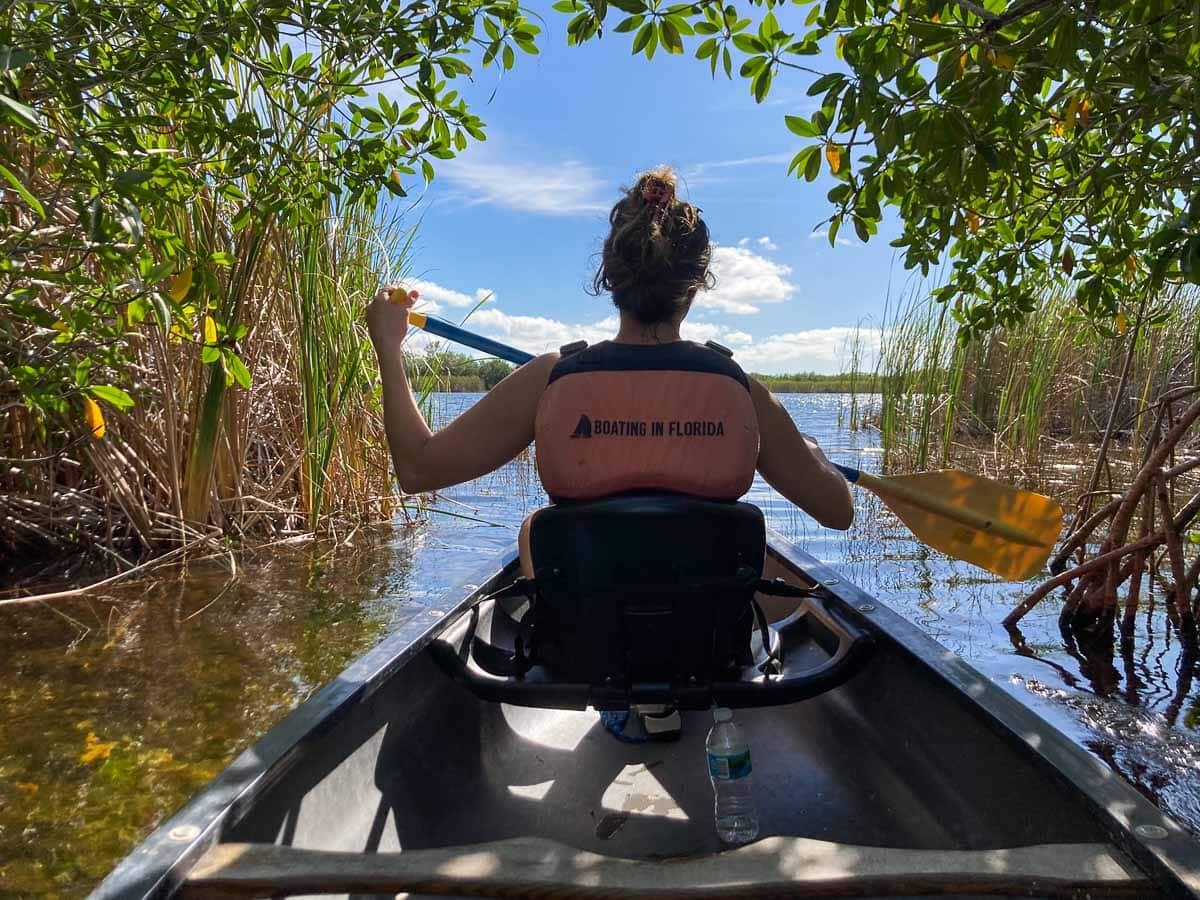
Nine Mile Pond Canoe Trail offers a bird-watching adventure that’s a bit different from the usual footpath. Grab a paddle and explore the Everglades by Water to get up close and personal with the scenery and the birds that inhabit it.
Canoeing
Paddling through these serene waters opens up a new bird-watching world. Canoeing allows for a quieter approach, perfect for observing water birds in their natural settings. You can expect species like the tricolored heron and little blue heron gliding elegantly across the Water’s surface.
Rentals
Fishing equipment rentals are available nearby if you don’t have your canoe or kayak, simplifying your preparation work. The trail is well-marked, but it’s always a good idea to familiarize yourself with the route and bring a map or GPS device to ensure a smooth journey.
Trail
This trail is about five miles long and typically takes around four hours to complete, so pack some essentials to keep you comfortable. Water, snacks, sunscreen, and a hat will make your trip more enjoyable. Birding in a canoe requires a bit of balance when reaching for those binoculars, so practice landing your paddle safely in your lap before diving into bird spotting.
Remember, bird activity is most vibrant during mornings and late afternoons, so plan your adventure accordingly. Seeing the Everglades from a canoe is an entirely immersive experience, offering unparalleled views and a chance to connect deeply with nature.
Flamingo Visitor Center Trails: A Family-Friendly Option

The Flamingo Visitor Center area is one of my favorite spots for families or anyone looking for a variety of short and accessible trails along the bird-watching trails in the Everglades. As the southernmost visitor center in Everglades National Park, it offers several easy trails that allow you to spot an incredible variety of birdlife. Whether you’re just starting your bird-watching journey or looking for a laid-back day, this area never fails to impress.
Fresh and Saltwater Environment
Here, a mix of fresh and saltwater environments draws diverse birds, from flamingos and pelicans to osprey swooping gracefully in search of fish. With such a dynamic list of feathered visitors, there’s always something to marvel at.
Guy Bradley Trail
For families, the Guy Bradley Trail is a great pick. It’s a short, easy stroll from the visitor center, perfect for introducing young bird watchers to the joys of spotting different species. The trail hugs the shoreline, offering sweeping views that make each step worthwhile.
Eco Pond
Another great spot is Eco Pond, which invites a closer look at the area’s bird life. This small, shallow pond acts like a magnet for waders and songbirds, and it’s an excellent spot for photographers trying to capture that perfect shot.
Planning your visit to coincide with bird-watching programs or ranger-led tours can be a huge plus. These programs often provide insights and tales about the species you encounter, tailored to engage kids and adults alike.
Don’t forget to check out the visitor center itself. Here, you can gather more information on trails, get a bird checklist, and learn about the unique ecosystems present in the Everglades. Plus, it’s a good spot to restock on Water, snacks, or any essential gear you might need for your adventure.
Guided Bird-Watching Tours: Making the Most of Your Experience
Joining a guided bird-watching tour in the Everglades can vastly enhance your experience, especially if you’re new to the area or bird-watching. These tours are a great way to explore the bird-watching trails in the Everglades with an expert guide, helping you spot and identify species you might otherwise miss.

Knowledge of the Guides
One big perk of these tours, based on my experience, is the knowledge of the guides. They have an in-depth understanding of the park’s diverse habitats and an uncanny knack for spotting even the most well-camouflaged birds. They know exactly when and where to look, sharing insights that transform a regular walk into an educational adventure.
Variety of Tours
The variety of tours available means there’s something for everyone. From early morning walks perfect for catching the sun-loving waders to twilight tours that introduce you to the nocturnal side of birdlife, these tours cater to all interests.
Not to mention, these guides often have great stories. Whether it’s about a particular bird’s unique call or its migration journey, their tales bring the species to life in ways that a guidebook might not.
Tours also typically provide gear like binoculars and bird guides, which is a bonus if you’re traveling light or forgetful—like me. And it’s not just birds. Guides can point out other wildlife and plants, giving you a rounded sense of the Everglades ecosystem.
Reviews and Recommendations
When choosing a tour, read reviews or ask for recommendations to find one that suits your curiosity and pace. Group sizes, duration, and specific focuses, like photography or family-friendly options, can vary, so pick what matches your preferences best.
Guided tours are a top-notch option for anyone eager to see the Everglades through the eyes of experts and make sure they’re not missing out on anything amazing. They provide sightings and stories, context, and a sense of connection to this remarkable landscape.
Bird Watching Ethics and Conservation in the Everglades
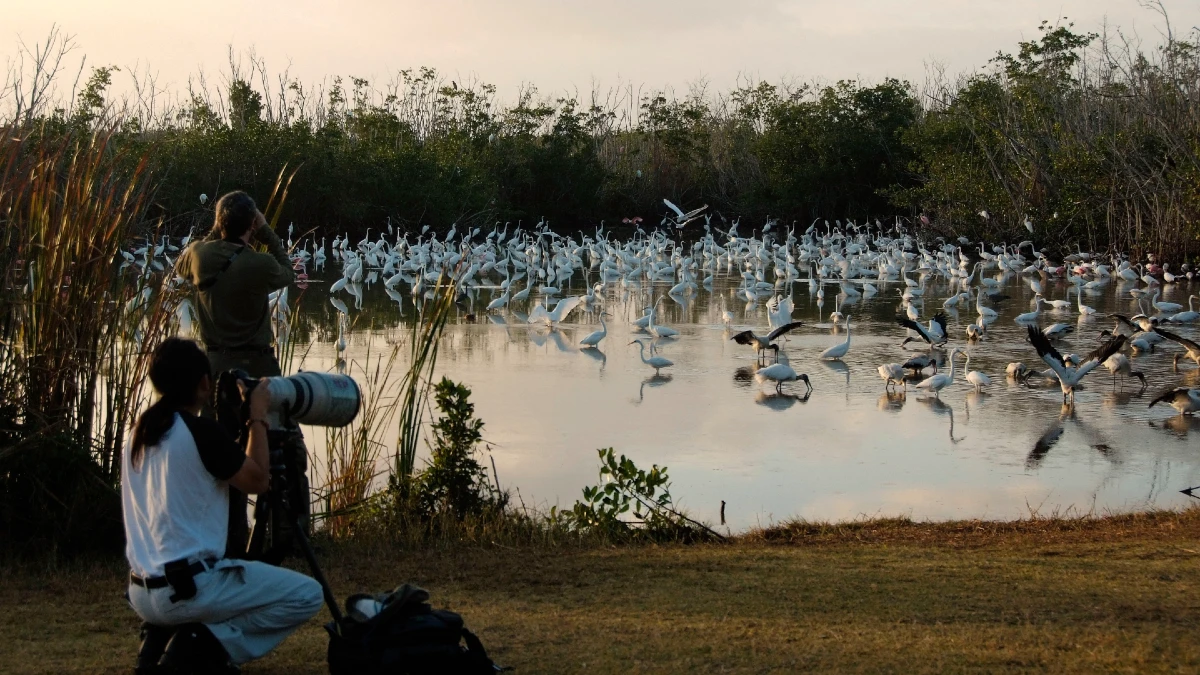
Bird-watching trails in the Everglades offer an unforgettable experience, where bird-watching is a delightful pursuit and a privilege. As visitors in this fragile ecosystem, ethical bird watching must be practiced to respect the wildlife and their habitat.
Respectful Distance
One of the fundamental aspects of ethical bird watching is maintaining a respectful distance from the birds. This means using binoculars for a closer look rather than getting too close and possibly disturbing them. Birds in the Everglades need to conserve energy for survival, particularly during migration periods.
Stick to Trails and Boardwalks
Stick to designated trails and boardwalks to protect the sensitive environments around you. The Everglades is home to countless interdependent species; even small disruptions can have significant impacts.
Avoid Feeding
Avoid feeding wildlife, as it can alter their natural behaviors and diets, potentially leading to health issues. These birds must remain wild and self-sufficient, contributing to the ecosystem’s natural balance.
Support Conservation Efforts
Supporting conservation efforts in the Everglades is another way to give back while indulging in bird watching. This can be as simple as participating in local clean-up efforts, donating to conservation programs, or volunteering for research projects on birds and their habitats.

What's Inside
Bird Watching for Conservation
By following these practices, you enrich your bird-watching experiences and contribute to preserving the Everglades for future generations to enjoy. It’s about being part of something bigger and ensuring these remarkable birds and their habitats are around for years.
Here’s an additional video about bird watching.
By: Mik Swe
Wrapping Up: Why the Everglades is a Must-Visit for Bird-Watching Enthusiasts
In conclusion, the Everglades is a bird-watcher’s paradise, offering an array of trails that cater to all levels of birding enthusiasts. From the accessible Anhinga Trail to the serene Nine Mile Pond Canoe Trail, each spot offers a unique experience, rich with birdlife and natural beauty. Whether you’re drawn to the bustling waters teeming with waders or the quiet canopy home to songbirds, the Everglades’ diverse ecosystems ensure that there’s always something new to discover.

For me, these trails have not only been an opportunity to spot incredible birds but also a chance to connect deeply with the natural world. As I reflect on my birding adventures here, it’s clear that the Everglades is a special place where every visit can reveal something extraordinary. Whether you’re a seasoned birder or a first-time visitor, the Everglades has something to offer—making it an absolute must-visit destination for anyone passionate about bird watching.
FAQS
What Are the Best Times of Year to Go Bird Watching in the Everglades?
-
Fall (September-November): Many migratory birds arrive in the Everglades during this time, making it a fantastic bird-watching period.
-
Winter (December-February): This is a great time to spot wintering waterfowl and shorebirds.
-
Spring (March-May): Witness the incredible spectacle of bird migrations as they head north.
What Are Some of the Must-see Birds in the Everglades?
The Everglades is home to a diverse array of bird species, including:
-
Wading Birds: Roseate Spoonbill, Great Blue Heron, Snowy Egret, Anhinga
-
Raptors: Bald Eagle, Osprey, Peregrine Falcon
What Are Some Tips for Successful Everglades Bird Watching?
-
Early Mornings and Late Evenings: These are the best times to spot birds as they are most active.
-
Use Binoculars and a Bird Identification Guide: These will greatly enhance your bird-watching experience.
-
Be Patient and Quiet: Birds are easily startled, so move slowly and quietly.
-
Consider a Guided Tour: A knowledgeable guide can help you locate and identify birds.
-
Dress Appropriately: Wear comfortable clothing, sunscreen, and insect repellent.
Eager to Explore Florida’s Best-Kept Secrets?
Become part of the Florida Splendors community and dive into a journey of adventure and discovery! Find hidden gems, bond with like-minded explorers, and share your love for the Sunshine State. From serene kayaking adventures and sun-soaked beaches to the excitement of lively cities, there’s something here for everyone!
Follow us on:
Let’s embark on Florida’s greatest adventures together!

